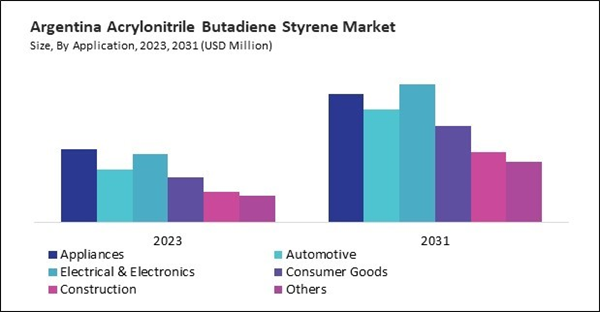In the Acrylonitrile Butadiene Styrene (ABS) market, Flame Retardant grade refers to a specific formulation tailored to enhance the fire resistance properties of ABS polymers. ABS, known for its toughness, impact resistance, and heat stability, is widely used in various industries including automotive, electronics, and construction. The Flame Retardant grade incorporates additives that inhibit or suppress combustion, thereby reducing the material's flammability and improving its safety profile in applications where fire risk is a concern. Thus, the Brazilian market consumed 42.13 kilo tonnes of flame retardant grade chemical in 2023.
The Brazil market dominated the LAMEA Acrylonitrile Butadiene Styrene Market by Country in 2023, and is forecast to continue being a dominant market till 2031; thereby, achieving a market value of $1.10 billion by 2031. The Argentina market is showcasing a CAGR of 9.5% during (2024 - 2031). Additionally, The UAE market would register a CAGR of 8.3% during (2024 - 2031).
Innovations in the acrylonitrile butadiene styrene market are driven by the need to enhance performance, sustainability, and cost-effectiveness. For example, Companies are developing ABS resins derived from renewable sources such as bio-based acrylonitrile and butadiene, reducing reliance on fossil fuels and lowering carbon footprint. These bio-based ABS materials offer similar mechanical properties and processability to conventional ABS while offering environmental benefits.
Recycling technologies are being developed to reclaim post-consumer and post-industrial ABS waste, diverting plastic from landfills and reducing resource consumption. Recycled ABS materials are used in various applications, including packaging, consumer goods, and automotive components, contributing to circular economy initiatives.
Dubai is known for its iconic skyline, dominated by skyscrapers and high-rise buildings. The construction of these towering structures requires a wide range of materials, including ABS, for applications such as exterior cladding, windows, doors, and interior fittings. ABS suppliers in Dubai can capitalize on the demand for specialty ABS grades that offer superior weather resistance, UV stability, and aesthetic appeal to withstand the harsh desert climate and enhance the visual impact of skyscrapers. As per the Dubai Statistics Center, in 2022, there were 13,236 buildings under construction in Dubai and 1,941 completed buildings. Rapid urbanization has increased demand for housing, commercial spaces, and public amenities. Cities like Dubai and Abu Dhabi have grown substantially, requiring more infrastructure and real estate developments. In conclusion, the increasing construction activities in the region propel the market’s growth.
List of Key Companies Profiled
- SABIC (Saudi Arabian Oil Company)
- BASF SE
- Formosa Plastics Group
- DuPont de Nemours, Inc.
- Kumho P&B Chemicals., Inc (Kumho Petrochemical Group)
- CHIMEI Corporation
- Trinseo PLC
- PetroChina Company Limited (China National Petroleum Corporation)
- Asahi Kasei Corporation
- INEOS Styrolution Group GmbH
Market Report Segmentation
By Type (Volume, Kilo Tonnes, USD Billion, 2020-2031)- Opaque
- Transparent
- Colored
- Emulsion Polymerization
- Continuous Polymerization
- Mass Polymerization
- Others
- High Impact
- Heat Resistant
- Electroplatable
- Flame Retardant
- Blended ABS
- Injection Molding
- Extrusion
- Thermoforming
- Blow Molding
- 3D Printing
- Appliances
- Automotive
- Electrical & Electronics
- Consumer Goods
- Construction
- Others
- Brazil
- Argentina
- UAE
- Saudi Arabia
- South Africa
- Nigeria
- Rest of LAMEA
Table of Contents
Companies Mentioned
- SABIC (Saudi Arabian Oil Company)
- BASF SE
- Formosa Plastics Group
- DuPont de Nemours, Inc.
- Kumho P&B Chemicals., Inc (Kumho Petrochemical Group)
- CHIMEI Corporation
- Trinseo PLC
- PetroChina Company Limited (China National Petroleum Corporation)
- Asahi Kasei Corporation
- INEOS Styrolution Group GmbH
Methodology

LOADING...









